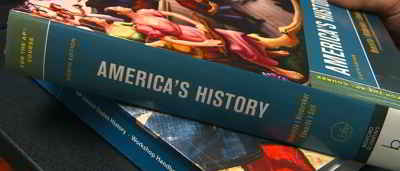

Pennsylvania History
Historic Facts & Overview of Pennsylvania History
Take a peek at Pennsylvania history. Discover an overview of Pennsylvania's rich history, heritage, historic events, and culture.
Although Swedes and Dutch were the first European settlers, William Penn, a Quaker, named Pennsylvania in honor of his father by combining the name Penn and the Latin term sylvania, which translates as "woodlands," to come up with "Penn's woodlands." Known as the "Keystone State," Pennsylvania is one of the original 13 colonies (it entered the Union in 1787). Today, two major cities dominate the state--Philadelphia, home of the Liberty Bell, Constitution Hall, and a thriving metropolitan area, and Pittsburgh, a busy inland river port. The Amish, a group of people who live without the use of modern technology, live in the countryside of Pennsylvania. The capital is Harrisburg and the state bird is the ruffed grouse.
Overview of Pennsylvania History and Heritage
In 1643, the Governor of New Sweden, Johan Printz, established a capital for his colony near present-day Philadelphia and called it Tinicum Island. It was the first permanent settlement in the Pennsylvania region.
Problems developed between the Swedes and the Dutch who were operating trading posts throughout the area. In 1655, the Dutch, led by Peter Stuyvescent of the colony of New Netherlands, seized New Sweden. The Dutch controlled the area until the English Duke of York took possession in 1664. The Duke continued to be in charge of the area until 1681 when King Charles II, with the Duke's support, granted the Pennsylvania region to William Penn. In 1682, the Duke presented Penn with the land that is now present-day Delaware. Delaware remained part of Pennsylvania until the time of the American Revolution.
William Penn, the son of an English admiral, was a member of the Society of Friends, also known as the Quakers. The Quakers were a persecuted religious group seeking freedom of worship. Penn hoped to establish a colony in the New World that would allow people of all faiths to worship freely. Penn decided to call his colony "Sylvania," which means "woods." King Charles added "Penn" to the name in honor of William's father.
William Markham, Penn's cousin, was appointed deputy governor of the colony in 1681. Markham, following Penn's instructions, established a government and laid out plans for the city of Philadelphia, which means brotherly love in Greek. When Penn arrived in his colony a year later, he brought with him a carefully written constitution for Pennsylvania that guaranteed religious freedom for all people. The constitution also supported liberation (freeing) of slaves and provided a framework for a colonial government.
Penn, as governor of the colony, established a strong friendship with the Native Americans. He purchased most of the land granted to him by King Charles from the Indians. Penn died in 1718, but his family governed the colony until the Revolutionary War began in 1775.
By the time of Penn's death, the colony had grown considerably. It was populated by many diverse cultural groups who had sought religious freedom in "Penn's Woods." They included the Germans, Scotch-Irish, Welsh, French Huguenots, Jews, Dutch, and Swedes. This cultural and religious diversity had a strong impact on the development of colonial Pennsylvania.
The French and Indian War began in western Pennsylvania in 1754 and resulted in many brutal battles. It was a conflict that grew out of Native American resentment to the westward expansion by colonial settlers. Pennsylvania Indians allied with French settlers who were establishing strongholds in the Ohio valley. Fighting continued in the colony until 1758 when the French left Pennsylvania. The war ended in 1763. Many attempts at resolving conflicts between the colonists and Native Americans had failed. Gradually, the colony's Indian population began migrating westward and out of Pennsylvania.
At the dawning of the American Revolution, Pennsylvania was the third largest colony in America. Philadelphia was the second largest English-speaking city in the world. But discontent was growing among the colonists. England had begun to impose taxes and trade restrictions on the American colonies. In 1774, the First Continental Congress met in Philadelphia to discuss the issue. Anger over taxation soon grew into a desire for independence from England.
The Revolutionary War began in April of 1775. One month later, the Second Continental Congress voted in favor of independence from Britain. The delegates in the Pennsylvania State House (Independence Hall) adopted the Declaration of Independence on July 4, 1776.
Several battles of the Revolution took place within Pennsylvania. British troops invaded the colony in 1777, captured Philadelphia, and occupied the city until 1778. General George Washington and his troops were unsuccessful in forcing the British out of the city. After suffering defeats in the battles of Brandywine and Germantown, Washington led his troops to Valley Forge where they spent the winter of 1777 and spring of 1778.
The Continental Congress was relocated to Lancaster and then York during British occupation of Philadelphia. While in York, Congress adopted the Articles of Confederation, which Pennsylvania ratified (approved) in 1778. The British withdrew from Philadelphia in June of 1778 and congress returned to the city. By 1783, the American Revolution had ended. When the Constitutional Convention met in Philadelphia in 1787, Pennsylvania became the second state to ratify the United States Constitution. Philadelphia remained the seat of government until 1800 when it was moved to Washington, D.C.
Many Pennsylvanians opposed slavery, supported the abolitionist (antislavery) movement, and gave strong support to the Union during the Civil War (1861-1865). Gettysburg, Pennsylvania, was the site of one of the bloodiest battles of the Civil War in July of 1863. More than 50,000 casualties resulted from this three-day battle.
On November 19, 1863, President Abraham Lincoln delivered his famous Gettysburg Address on a portion of the battlefield, dedicating it as a final resting place for those who had died there.






